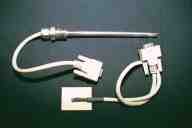

The sparge vessel is a 60 quart Vollrath pot. I purchased the pot (and lid) from Something's Brewing, 196 Battery Street, Burlington, Vermont 05401, (802) 660-9007, Somebrew@aol.com. I had P.B.S. modify the Vollrath pot to include,
This was my original water level indicator design. It uses a Bourns 10-turn 20 K ohms potentiometer. A metal rod is attached to a large copper float. A string attaches to the top of the rod, wraps around a small wheel attached to the potentiometer and attaches to the bottom of the rod just above the float. Five volts is applied to the potentiometer which serves as a simple voltage divider. The output voltage is linearly proportional to the level of the water.
This water level indicator is quite accurate. It works well in the sparge vessel because the sparge/dough-in water is never brought to a boil. It wouldn't work well measuring the volume of boiling wort. The biggest problem I have with this indicator is mechanical. The float and rod assembly doesn't move up and down as smoothly as it should and consequently, the measurement tends to be rather herky-jerky.
This sensor will ultimately be replaced with the pressure transducer
water level indicator used with the boil vessel.
The bottom of the 1" N.P.S.M. fitting is welded just above where the curved bottom of the pot meets the side. This minimizes the water which is below the element. It's important that the water still covers the sparge heater element when the water level indicator indicates zero. Power is applied to the sparge electric water heater element until the water level indicator reads zero. With a pressure transducer water level indicator, a float switch will be used to ensure the level of the dough-in/sparge water never drops below the level of the sparge heater element.
I use a 120 volt, 1500 watt electric water heater element. I use
the electric heater element in conjunction with a 35,000 BTU propane
stove when initially heating the dough-in water, but I use the
electric heater element alone to maintain the temperature of the
dough-in and sparge water. The electric heater element does an
excellent job of maintaining the temperature of the water within
the sparge vessel.

I use a National Semiconductor temperature sensor. The temperature sensor is available calibrated in Fahrenheit (LM34) and Centigrade (LM35). The temperature sensor is available in three packages: LM34DH, Metal Can Package; LM34DZ, Plastic Package; and LM34DM, 8-Lead Surface Mount Small Outline Molded Package. The output of the device is 10 mV for each degree in Fahrenheit and Centigrade. I chose the LM34 Fahrenheit temperature sensor over the LM35 Centigrade temperature sensor because the Fahrenheit temperature sensor offers 1.8 times better resolution. I chose the plastic package.
My thermowell is a closed protection tube and a compression fitting,
The temperature sensors is wired to a shielded serial cable with a DB-15 connector. A mating DB-15 connector is mounted on the stainless steel work surface of the rack.
The temperature sensor should probably be epoxied into the thermowell.
But I wasn't exactly sure what kind of life I was going to get
out of the temperature sensor and this would make the protection
tube disposable. Even though the cable has a convenient connector,
I opt to remove the sensor from the protection tube when I remove
the sparge vessel.
One poor decision I made was the placement of the electric heater element fitting with respect to the thermowell fitting. Somehow, I decided that the temperature measurement would be more accurate if the thermowell was directly adjacent to the heater element. The sparge vessel is 16" in diameter. Both the thermowell and the heater element protrude about 6" into the pot. What I failed to take into account was that someday, I may want to use a longer, more powerful heater element.
I plan to introduce a 4500 watt, 240 volt heater element (see Credits) into the sparge vessel. The 1" N.P.S.M. fitting is approximately ¾" wide. With this, the 16 3/8" 4500 watt heater element is just contained within the 16" diameter pot. Due to the orientation of the existing 1" N.P.S.M. fitting and the ½" F.P.T. fitting, I will be forced to introduce a second 1" N.P.S.M. fitting which is 90º from the other two.
In the end, this may work out for the best. I can use the 4500 watt heater element to heat the dough-in and sparge water in a hurry and use the 1500 watt heater element to simply maintain the temperature.